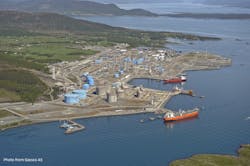Gassco AS, operator for Gassled—a joint venture of oil and gas companies on the Norwegian continental shelf and the owner of Norwegian gas transportation systems—is planning to boost capacity for handling rich gas by yearend at its 90 million-cu m/day Karsto gas processing plant near Haugesund, on Norway's west coast.
Approved at the beginning of 2015, the expansion will include modifications designed to increase the plant’s rich-gas processing capacity by 5.7 million cu m/day, Gassco said in its 2015 annual report released on Apr. 5.
The expansion is due to be completed and operational by the start of the 2016 contract year on Oct. 1, the company said.
While Gassco disclosed no further details regarding Karsto’s capacity expansion project, the company did confirm the plant is scheduled for an upcoming planned maintenance shutdown this year.
Gassco will execute the Karsto turnaround in conjunction with work to phase in upgraded systems as part of its Kalsto robustness project (KaRP), which aims to rehabilitate aging installations at the 30-year-old Kalsto landfall facility where the Statpipe, Sleipner Condensate, and Asgard Transport pipelines come ashore.
KaRP, which began in September 2014, is scheduled to be completed by 2017, the company said.
During the past 7 years, Gassco has invested nearly 10 billion kroner on upgrades at the Karsto plant (OGJ, July 5, 2010, p. 18; OGJ Online, Dec. 12, 2012; Aug. 30, 2011; July 15, 2010), the most recent of which includes a 600 million-kroner project to upgrade two steam boilers that was completed in 2015, according to a June 3, 2015, release from the company.
Gassco said it also is evaluating an additional investment of about 1 billion kroner on a project to upgrade Karsto’s fire water and blowdown systems, as well as two additional boilers.
A final investment decision on that project is due sometime this fall.
Karsto overview
The Karsto gas processing plant, which receives gas and condensate supplies from via pipeline from 28 fields on the Norwegian continental shelf, for processing and subsequent delivery to Europe.
With a combined NGL and condensate production capacity of about 10 million tonnes/year, the plant is equipped with the following individual production capacities: ethane, 112 tonnes/hr (tph); propane, 385 tph; i-butane, 76 tph; n-butane, 145 tph; naphtha, 106 tph; and condensate, 351 tph.
Contact Robert Brelsford at [email protected].
